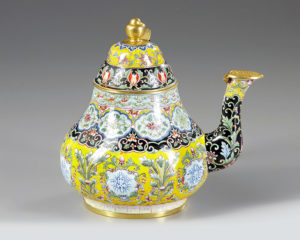 By Anne Gilbert
By Anne Gilbert The first thing that catches your eye are the vivid colors. Next, that even though the object appears to be porcelain it is entirely something else. A tap of your finger tells you it is metal with a painted enamel glaze. You are looking at an example of Chinese painted enamels. Back in the 1970s, 80s it was quite affordable and often went urecognized in antique shops.
Over the centuries many enameling techniques were used. Among them cloisonné and champlevé. The technique of enamel painting used colored glass fluxes painted as on porcelain, but using copper, silver, gold or bronze surfaces. The result was a vivid color palette.
Over the centuries, going back to early Egypt, paintings of enamel on metal were used. During the Renaissance colored enamel designs were used like paint on metal objects.
Before the 1970s, the 19th century cups, saucer, vases and bowls that gathered dust in shops were all show staples. They were considered gaudy, commercial export pieces. There were few if any examples in museums and not much documentation. An exhibit in the 1970s organized by the China Institute in New York and the Ashmolean Museum of Oxford created a small awareness. However, it was a show of over 100 pieces at the E & J Frankel Gallery in New York, in 1991 that alerted collectors and dealers. The Frankel Gallery still offers a collection of Chinese enamel painting on metals.
CLUES: Because the enamel surface is fragile, many early pieces can have chips and scratches. This is especially true of the 19th century pieces. A clue to the older pieces is the quality of the design and decorative details.
Historically, pieces were thought to have been made first in the late 17th century, and by Jesuit missionaries schooled in the making of Limoges enamels.
By the late 18th century the technique had been perfected and delicate designs and forms were used. However, as the social order began its downward spiral in 19th century China and imperial patronage to the arts disappeared, so did the quality of workmanship.
A great variety of forms were used. One of the most charming were sea shell forms. There were also figurals of animals.
These days when it is recognized and not mis-labeled as cloisonné, prices at auction can be in the thousands of dollars. A piece doesn’t have to be old to be costly. Vintage vases are selling for thousands of dollars.
PHOTO CAPTION: (1) Chinese teapot, painted enamel of copper. PHOTO CREDIT: Oriental Art Auctions















Follow Us